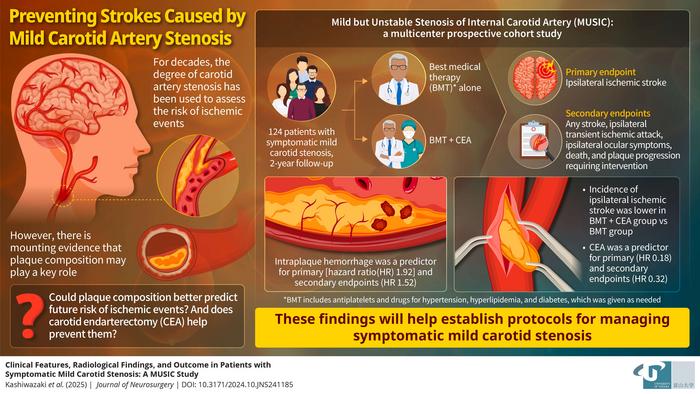
Ischemic stroke continues to rank among the most devastating medical conditions worldwide, inflicting millions with death or long-term disability each year. A significant proportion of these strokes—up to 30%—are attributed to narrowing of the carotid arteries, large vessels supplying blood to critical brain regions. Traditionally, clinical risk assessment and treatment decisions have been dominated by quantifying the degree of stenosis, or arterial narrowing, with more severe constrictions presaging higher risk. However, groundbreaking new evidence emerging from a prospective, multicenter cohort study now challenges the long-held dogma that luminal stenosis alone dictates stroke risk, especially in patients presenting with symptomatic but mild carotid artery narrowing.
Patients classified as having mild carotid stenosis—less than 50% narrowing—have conventionally been considered low risk for recurrent ischemic events and thus managed conservatively with medical therapy alone. Yet clinical experience reveals a troubling paradox: despite optimal best medical therapy (BMT), a considerable subset of these patients continue to suffer strokes or transient ischemic episodes, signaling that traditional metrics may inadequately capture true vulnerability. This perplexing clinical scenario has galvanized researchers at Toyama University in Japan to investigate novel predictors of stroke risk beyond luminal stenosis severity.
Led by Lecturer Dr. Daina Kashiwazaki and neurosurgeon Dr. Satoshi Kuroda, the “Mild but Unstable Stenosis of Internal Carotid Artery” (MUSIC) study enrolled 124 patients across multiple centers who had suffered cerebrovascular or retinal ischemic events ipsilateral to mild carotid stenosis. The study, published in the prestigious Journal of Neurosurgery in early 2025, set out to rigorously characterize the clinical features, detailed radiological plaque characteristics, and longitudinal treatment outcomes in this underappreciated patient cohort. Importantly, all participants received best medical therapy tailored to their risk factors, while approximately half also underwent surgical intervention via carotid endarterectomy (CEA) or carotid artery stenting (CAS).
What sets the MUSIC study apart is its intensive focus on plaque composition, rather than solely the degree of arterial narrowing, as a determinant of future ischemic events. Advanced neuroimaging techniques identified a strikingly high prevalence of unstable plaque features in the cohort: around 81% exhibited radiologically unstable plaques, and nearly 60% harbored intraplaque hemorrhage (IPH)—a pathologic hallmark indicative of plaque vulnerability and active disease. IPH, characterized by bleeding within the atherosclerotic lesion, is known to accelerate plaque progression, increase inflammation, and dramatically elevate the risk of rupture and thrombosis.
The prognostic implications of these findings were profound. Patients with IPH faced a significantly elevated risk of ipsilateral ischemic stroke and other cerebrovascular endpoints, including ocular ischemic symptoms and progression necessitating surgical intervention. Critically, the incidence of ischemic stroke over two years was substantially lower—just 1.7%—in patients who received surgical plaque removal via CEA compared to 15.1% in those managed with best medical therapy alone. These data unequivocally position plaque instability and hemorrhagic components as pivotal risk modulators, overshadowing luminal stenosis percentage in symptomatic mild carotid disease.
Such insights disrupt existing clinical guidelines that traditionally reserve CEA for patients with moderate to severe stenosis, generally excluding those with mild disease. The MUSIC study’s findings advocate for a paradigm shift towards personalized stroke prevention strategies that incorporate detailed plaque imaging to stratify risk and guide treatment. By identifying high-risk patients with unstable plaque features early, clinicians could intervene surgically before disabling ischemic events occur. This more nuanced approach holds the promise to transform prophylactic stroke care in millions worldwide.
Another remarkable facet highlighted by the study is the observation that nearly half of the participants were already receiving antithrombotic agents prior to enrollment but continued to experience ischemic events. This suggests that conservative medical management alone may be insufficient, or that therapeutic resistance may exist in this subgroup with unstable mild carotid stenosis. The identification of such resistance underscores the urgent need for alternative strategies, including surgical plaque removal, to avert catastrophic outcomes.
From a pathophysiological perspective, the study reinforces the concept that the composition and biological activity of atherosclerotic plaques—rather than static luminal narrowing—drive the natural history of ischemic stroke risk. Intraplaque hemorrhage triggers a vicious cycle of inflammation, neovascular proliferation, and plaque destabilization, which culminate in embolic strokes even in arterial segments with less than 50% stenosis. These dynamic plaque processes cannot be captured by traditional angiographic stenosis assessment, necessitating advanced imaging modalities such as high-resolution magnetic resonance imaging (MRI) for adequate risk appraisal.
The potential clinical repercussions of adopting plaque composition evaluation are sweeping. Preoperative assessment of IPH and other high-risk plaque morphologies would enable neurosurgeons and neurologists to tailor individualized treatment plans, selectively recommending carotid endarterectomy for those who stand to benefit most while sparing low-risk patients from unnecessary surgery. This approach promises to enhance patient safety, improve functional outcomes, and optimize resource allocation in vascular neurosurgery.
Looking ahead, the MUSIC investigators envision integrating plaque characterization into routine clinical algorithms for all individuals presenting with symptomatic mild carotid stenosis. This forward-thinking strategy departs from the traditional stenosis-threshold model and advocates for a more sophisticated, biology-driven framework that addresses the heterogeneity of atherosclerotic disease. Through wider adoption, such paradigm shifts could ultimately reduce the global burden of stroke by intercepting high-risk patients before irreversible neurological damage occurs.
While the study’s prospective design and multicenter enrollment strengthen its validity, further research is warranted to corroborate these findings across diverse populations and to refine imaging protocols and treatment thresholds. Moreover, investigating adjunctive pharmacotherapies aimed specifically at stabilizing vulnerable plaques represents a promising avenue to complement surgical interventions. Ultimately, multidisciplinary collaboration combining advanced neuroimaging, vascular neurosurgery, and precision medicine will be vital to translating these insights into clinical practice.
In conclusion, the MUSIC study from Toyama University decisively challenges the prevailing clinical mindset that views symptomatic mild carotid stenosis as inherently low risk. By illuminating the critical role of plaque instability and intraplaque hemorrhage in precipitating recurrent ischemic events, this research heralds a new era in stroke prevention. The shift towards incorporating plaque composition evaluation into patient assessment heralds a future where individualized, mechanism-based interventions supplant crude stenosis metrics, offering new hope for patients previously deemed low risk yet suffering devastating strokes. This transformative work underscores the pressing necessity for personalized approaches in vascular neurology and neurosurgery and exemplifies the impact of targeted research in improving global health outcomes.
—
Subject of Research: People
Article Title: Clinical features, radiological findings, and outcome in patients with symptomatic mild carotid stenosis: a MUSIC study
News Publication Date: February 21, 2025
Web References: https://doi.org/10.3171/2024.10.JNS241185
References: Kashiwazaki D, Kuroda S, et al. Clinical features, radiological findings, and outcome in patients with symptomatic mild carotid stenosis: a MUSIC study. Journal of Neurosurgery. Published online February 21, 2025. DOI: 10.3171/2024.10.JNS241185
Image Credits: Lecturer Daina Kashiwazaki from Toyama University, Japan
Keywords: Carotid artery, Medical treatments, Risk factors, Ischemia, Atherosclerosis, Bleeding
Tags: atherosclerotic carotid stenosisbest medical therapy for strokecarotid artery disease managementcarotid artery stenosis treatmentclinical research on strokeischemic stroke risk factorsmild carotid artery narrowingneurological complications of carotid stenosisnew evidence in stroke preventionpredictive markers for strokestroke risk assessmenttransient ischemic attacks






